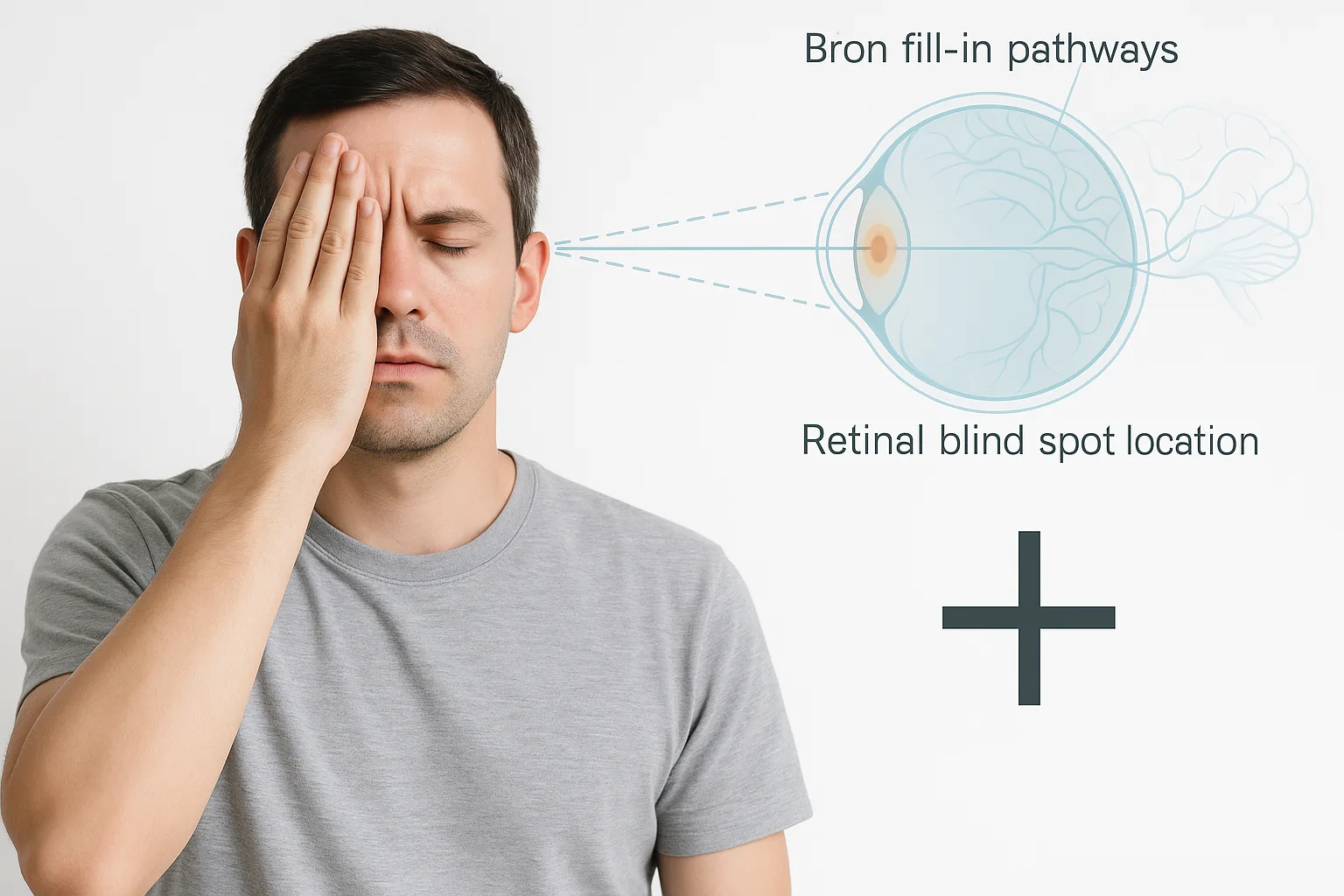Every human has a gap in their field of vision where the optic nerve connects to the retina. This area contains no light-detecting cells, meaning it cannot capture visual information. Yet you never notice this gap. Objects do not disappear, and your sight seems complete.
The reason is simple: your brain fills in the missing information automatically.
This phenomenon is exposed by the blind spot test, a quick and fascinating experiment that reveals how much of what you “see” is actually constructed by your brain.
This illusion shows that your visual world is not a perfect capture of reality — it is a reconstruction.
Let’s begin.
Step 1 — Draw Two Simple Marks on Paper
On a blank sheet of paper, draw:
- a small black dot on the left
- a small black plus sign (+) on the right
Leave around 10 to 12 centimeters between them.
Why this matters
You need two reference points so that one of them can disappear from your visual field during the blind spot test.
Step 2 — Close Your Right Eye and Focus on the Plus Sign
Cover your right eye gently with your hand.
Keep your left eye open.
Stare directly at the plus sign.
What’s happening now
Your brain begins anchoring your gaze, preparing to reveal your blind spot.
Step 3 — Slowly Move the Paper Toward You
While focusing on the plus sign:
- hold the paper at arm’s length
- move it slowly closer to your face
- do not shift your gaze
- do not look at the dot
What you’ll notice
At a certain distance:
the dot will disappear completely.
Even though it is still there on the page.
This is the blind spot test in action.
Step 4 — Continue Moving the Paper to Watch the Dot Reappear
Keep moving the paper slowly.
The dot will:
- reappear
- disappear again
- reappear once more
as it crosses the blind spot zone.
Why this happens
The dot falls into the region of your retina where no photoreceptors exist.
Your brain simply removes it from awareness and fills the space with background.

Step 5 — Repeat the Test Using Your Right Eye
Switch eyes:
- close your left eye
- stare at the dot
- move the paper again
What changes
Now the plus sign disappears instead of the dot.
Each eye has its own blind spot because each retina has a different optic nerve placement.
This step reinforces the blind spot test.
Step 6 — Try the Test With a Colored Background
Repeat the blind spot test using a colored surface:
- blue paper
- yellow paper
- green paper
What happens
When the dot disappears, the brain fills the blind spot with the exact same color as the background.
This proves that the brain does not leave the space blank — it reconstructs.
Step 7 — Try the Moving Dot Variation
Draw a line across a sheet of paper.
Place a dot somewhere on that line.
Move the paper horizontally.
What you’ll see
The line remains continuous, even though the dot disappears at certain positions.
Your brain fills in the missing segment of the line seamlessly.
This shows how the blind spot test exposes automatic pattern completion.
Step 8 — Try the Pattern Fill-In Illusion
Draw:
- a dot
- a grid
- or a textured pattern
Put the dot somewhere inside the pattern.
Repeat the test.
What happens
When the dot falls into the blind spot:
- your brain fills it with grid lines
- the texture appears “complete”
- the missing part is reconstructed
Your brain guesses what should be there.
This is one of the strongest demonstrations of perceptual filling-in.
Step 9 — Try the Distance Variation
Move the paper:
- farther
- closer
- slowly
- quickly
Why this matters
The blind spot appears at a specific angle.
Its size and location shift slightly depending on:
- head movement
- distance
- eye angle
- lighting
Exploring these variations deepens the understanding of the blind spot test.
Step 10 — What This Brain–Body Glitch Reveals About You
The blind spot test reveals crucial principles about vision and perception:
1. You have a permanent hole in your vision
This gap exists in both eyes.
2. Your brain fills the gap automatically
It reconstructs missing information to create a smooth image.
3. You rarely notice the blind spot
Your brain compares both eyes and fills the hole with detail.
4. Vision is not passive
It is an active construction.
5. Your eyes do not capture reality perfectly
Your brain edits, completes and invents parts of your visual field.
6. Pattern completion is automatic
Your brain guesses what belongs in the blind area.
7. You “see” what your brain decides you see
Not what your retina directly captures.
The blind spot test demonstrates that perception is not a camera — it is an interpretation.
Try the Next Brain–Body Glitch Experiment
If the blind spot test revealed how your brain fills missing visual information, the next illusion shows how your brain misjudges object size itself. You will experience how context can trick your perception instantly.
Next recommended experiment:
The Size–Context Illusion — Why Two Identical Objects Don’t Look the Same
